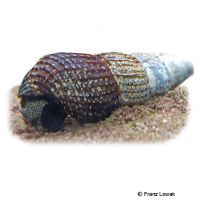Sulawesi Elephant Snail (Tylomelania bakara)
| Sulawesi Elephant Snail Tylomelania bakara | |
|---|---|
| Name | Sulawesi Elephant Snail |
| Name Lat. | Tylomelania bakara |
| Family | Pachychilids |
| Family lat. | Pachychilidae |
| Order | Snails & Slugs |
| Order lat. | Gastropoda |
| Origin | Sulawesi |
| Habitat | Lake Towuti |
| Diet | Algae, detritus, snail food |
| pH | 7.5-8.5 |
| Behavior | Peaceful |
| Keeping | Group |
| Care Level | Moderate |
| Reproduction | Livebearer |
| Breeding | Moderately difficult |
| Life Span | 4-6 years |
| Protection | No |
| Metric Units | |
| Size | 5-7 cm |
| Temperature | 26-32 °C |
| Hardness | 5-20 °dH |
| Aquarium | 60 l |
| US Units | |
| Size | 2"-2.8" |
| Temperature | 79-90 °F |
| Hardness | 89-356 ppm |
| Aquarium | 15 gal |
Distribution and habitat
The Bakara Tower Cap Snail is found exclusively (endemically) in Lake Towuti in Sulawesi, where they live mainly in shallow water, less frequently at greater depths on both hard and soft substrates.
Maintenance
They need a well-structured aquarium with roots, stones and plants. The substrate of sand or fine gravel should be partially covered with foliage (e.g. sea almond leaves, oak leaves), decaying plant material and mulm. Some shaded light and soft to medium hard water is ideal.
Water quality must be that required for average freshwater fish keeping. No ammonia, ammonium or nitrite should be detectable in the water and the nitrate level should be below 100 mg/l. When using a filter, make sure that only a weak current is created and that no animals can be sucked in. The lighting must correspond to the natural day-night rhythm of the animals.
Diet
They feed mainly on dead plant material (detritus) and algae growth, which is rasped off. The food supply consists of foliage, algae leaves, powdered dry food (flakes, tablets) with high vegetable content (spirulina) or a commercially available special dry food, which is well accepted after habituation.
Feeding should be varied to prevent the occurrence of deficiency symptoms. Unaccepted food must be removed after 2-3 hours.
Behaviour and compatibility
They should be kept in a small group of 4-6 animals. Socialization with fish and other invertebrates (shrimp, snails), which do not consider these snails as food, is well possible
Basically, only mutually compatible species with similar requirements for water conditions and water temperature should be socialized.
Reproduction and breeding
They are separately sexual and viviparous. The sexes can not be distinguished from each other externally
After mating, the young snails go through their development in the brood pouch of the female. There the eggs and developing young remain until they are born. The female gives birth to a juvenile every 1-2 months. The young grow up slowly. They can be well raised with dust food for ornamental fish.
Important
Aquatic plants are usually not eaten.
To build up their shells, they need a sufficient supply of lime. Especially in soft, acidic water, shell damage (holes) can occur due to a lack of lime, which can lead to the death of the snail. Therefore, special attention should be paid to the calcium concentration in the water and, if necessary, calcium should be added in the form of limestone, cuttlebone or special preparations from the specialized trade
Foliage (sea almond tree, oak, beech, etc.) not only provides cover, but when rotting promotes the development of microorganisms, which are a valuable secondary food source.
The well-being of the animals should be monitored regularly. Temperature should be checked daily, pH, hardness and nitrate levels at least every 14 days. Regular partial water changes are recommended, even when contaminant levels have not yet reached the upper limit. Sudden changes in water quality should be avoided. Newly introduced animals must be accustomed slowly to the water in the aquarium.
Further literature can be found in your pet store.
References
Text: petdata; Image: Franz Lowak
Source: BITTER (2008), Schnecken-Fibel, Dähne Verlag; ENGELMANN & LANGE (2011): Zootierhaltung - Tiere in menschlicher Obhut: Wirbellose, Verlag Harri Deutsch
